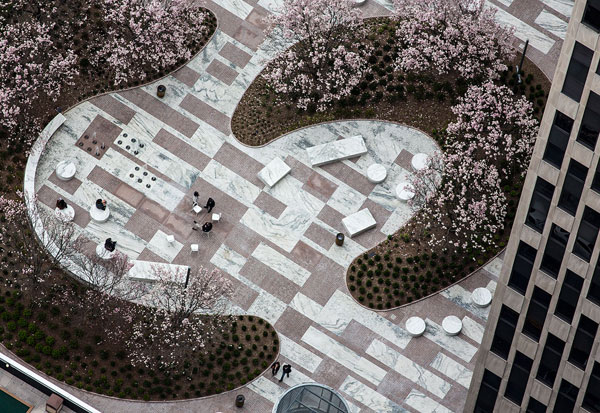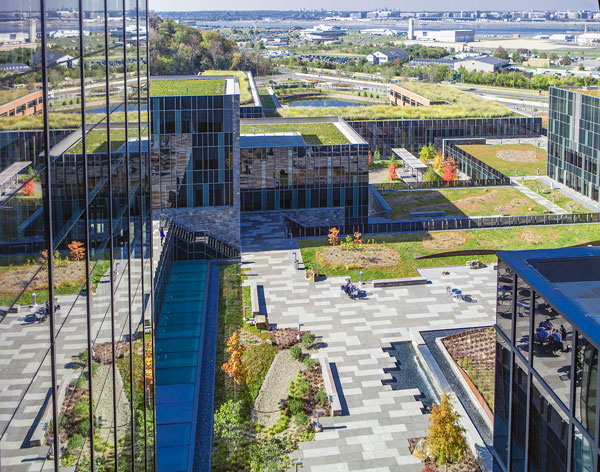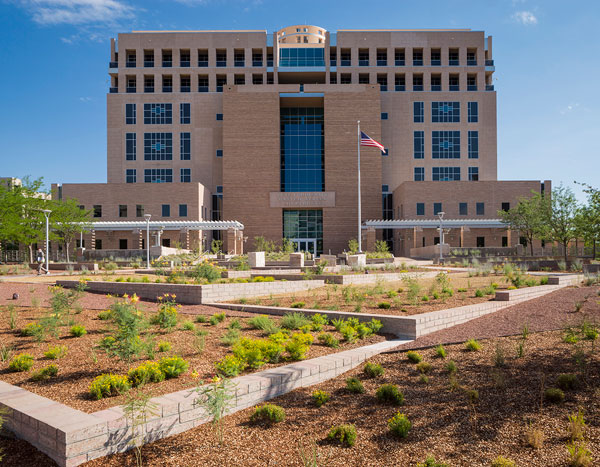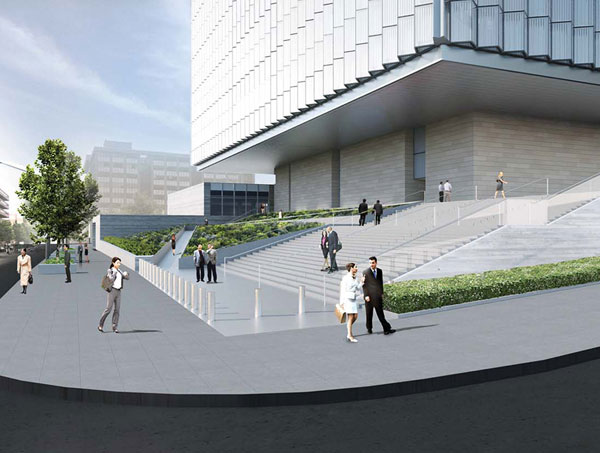News
Interview with Christian Gabriel, ASLA
 Christian Gabriel / Taylor Lednum, GSA
Christian Gabriel / Taylor Lednum, GSA
Since you began as the National Design Director for Landscape Architecture at the U.S. General Services Administration (GSA) two years ago, what has changed? Where is GSA now on landscape architecture?
In the last two years, GSA has established a landscape architecture presence that acknowledges the value of the field. When I arrived, landscape architecture issues and opportunities were addressed indirectly through other disciplines, sometimes falling through gaps between general design, architecture, art, or urban planning.
But GSA wanted to shift to a more holistic approach that acknowledged the value robust landscape architectural design can bring to our projects. We have been realizing that shift through the creation of policy guidance on landscape architecture; the selection of prominent landscape architects as national design peers; identification of project opportunities, including landscape exclusive projects and ecological services; and a new landscape architecture voice in capital project design review.
GSA has long-excelled at the art of sustainable building development, and now we’re beginning to bring the same attention to site design.
During the past two years GSA's new construction budget was slashed. In 2010 the budget was $800 million, but two years later that budget was down to just around $50 million. For this year though, Congress has allocated more than $500 million for some new facilities, such as the San Ysidro Point of Entry in California and an FBI complex in San Juan, Puerto Rico. What is your role in these high-profile projects? How will they showcase design excellence in landscape architecture?
It's easy to hang on the overall numbers because, like any federal agency, our budget ebbs and flows. Even when our overall capital construction budget goes down, our portfolio remains considerable since it takes quite a while to develop the large projects and programs in our pipeline. And we have a huge maintenance program to boot. Even those maintenance projects can be quite large and have the ability to catalyze change. For example, the Javits Federal Plaza project in New York City, designed by Michael Van Valkenburgh Associates, is an eloquent example of a major, well-designed work of landscape architecture that began as a waterproofing project identified and completed through our repair and alterations program.
 Jacob Javits Federal Building Plaza, New York City / Alex Maclean / Landslide Aerial Photography
Jacob Javits Federal Building Plaza, New York City / Alex Maclean / Landslide Aerial Photography
In terms of the role of landscape architecture in major projects moving forward, it will be like the role I established during leaner times: seek to be a clear-headed voice at the table, but also bring forward the value of landscape architecture in a variety of performance areas -- whether it's through ecological services or public space design.
The public realm in many of our projects is vitally important. For example, the San Ysidro point of entry is one of the busiest land ports in the world. It sees 30,000 to 50,000 pedestrians every day, and 60,000 to 80,000 vehicles a day. Public spaces there see volumes you rarely find anywhere outside of Times Square.
Another part of your job is educating GSA's 12,000 plus employees who manage nearly 9,000 buildings about the value of landscape architecture. That seems like a herculean task. What is your strategy for improving awareness? What landscape architecture issues do you think are most misunderstood there?
First, you have to get to the right people. There are people at the beginning of projects who provide significant direction, like chief architect Les Shepherd who shape the look, the feel, the design team. Another critical step is working closely with our regional design and construction teams and project champions, the folks that push the projects along, ensuring that they’re meeting all of the intended objectives and aspirations of the project. Then, when the project is turn-key and facility management takes the reins on behalf of one of our client agencies, it's critical to touch base and clarify the “care and feeding” of the projects to ensure the longevity of our landscapes and public spaces.
More broadly, we're focused on the education of all of our staff. We're providing continuing educational units for our professional staff on a near monthly basis. Ladybird Johnson Wildflower Center and other outside institutions and practitioners provide education on landscape architecture topics. We're also entering into the "landscape analytics" portion of our work where we're looking at some relatively sophisticated and complex landscapes that have a lot of embedded green infrastructure and are beginning to verify the performance of those projects. Many of our staff are incredibly knowledgeable about both design and construction and have demonstrated a real interest in understanding how complex landscape projects perform under field conditions.
During an ASLA-hosted webinar on how landscape architects can contract with GSA, you mentioned a short selection process that would allow local LAs to pre-qualify for GSA projects. Can you offer any more details on this process? When you expect GSA to roll it out?
We are always exploring how to enhance our contracting mechanisms and have been looking at two elements related to that: One has been the renewal of our indefinite delivery/indefinite quantity teams. The other is the potential for a short-selection process, which is really a pre-qualification for landscape specific firms. The latter element is only in a discussion stage.
Sustainability is now a key goal for the landscapes GSA manages, but GSA must also prove the benefits of sustainable design practices like green infrastructure outweigh the costs, so it has undertaken a broad effort to collect data and make the case. What kind of data are you collecting? Are there any interesting findings so far?
We're trying to bring forward the value of landscape architecture in measurable terms. Part of that is making clear the contributions of the landscape if we're suggesting that public money be spent on creating more intense functional landscapes to treat stormwater, sequester carbon, and produce electricity. There needs to be a commissioning process, similar to how we would commission a furnace in a building, proving to us all that it's functioning at a certain capacity. Often green infrastructure is assumed to be functioning at maximum capacity. We know in practice however that it’s actually very rare, because these are living systems not typically maintained at a perfect level or performing at a consistent level.
We’re planning to work with Landscape Architecture Foundation (LAF) on two projects we identified for our landscape analytic study, which explore these issues:
First is the new United States Coast Guard headquarters at the old Saint Elizabeth's Hospital site in Washington, D.C. It is a massive structure, set against a hillside in an historic campus, which hosts the third largest green roof in the world. The combination of on-grade and on-structure elements working together to provide diverse ecological services and zones for the overall project is astounding. We're planning to verify the performance of hydrologic networks and other sustainable features through a combination of on-site and secondary research, examining the construction, installation, and care.
 US Coast Guard Headquarters, Washington, D.C. / Taylor Lednum, GSA
US Coast Guard Headquarters, Washington, D.C. / Taylor Lednum, GSA
Second is the Domenici Courthouse in Albuquerque designed by Rios Clementi Hale Studios. This is a SITES-certified project, on a much smaller scale, and in a totally different eco-region, demonstrating an entirely different approach to sustainable landscape. The two projects should prove complementary.
 Domenici Courthouse, Albuquerque, New Mexico / Robert Reck
Domenici Courthouse, Albuquerque, New Mexico / Robert Reck
Carbon, water, and electricity are the three defining design issues of our day. We're hoping to tackle two of them within the realm of landscape. We are not alone in our interest: Our colleagues at Andropogon Associates, lead designers of the United States Coast Guard Headquarters landscape, have started similar research on other non-federal facilities. We’ve also recently been in touch with Reed Hilderbrand, a firm also looking at something similar, essentially a commissioning process for their Clark Institute of Art project in western Massachusetts.
Your work must incorporate security. Is there a new approach at GSA for using the landscape to improve security? You were talking about these point-of-entry projects where security needs to be visible. You need to know you're entering at this secure environment so there are symbols of security. But how do you balance creating a sense of security while also providing access and transparency?
There is the issue of preemptive security, the visual definition of security, so people understand a legible and secure envelope on a building or site as a deterrent. That is of great interest to our security-minded client agencies.
At this point, nearly all federal client agencies essentially self-identify the risk level of their own facility on a pre-defined scale. The Interagency Security Council develops all the standards and protocols, the hardening requirements of each level facility, if you will. So this issue is deceptively complex.
Regardless of the risk level however, the best path is integrated design. For example, the Los Angeles Courthouse, now in design and construction on a highly urban site, has a series of walls, planters, and bollards. It's the idiosyncratic deployment of those things, not in a singular, monolithic monotony that make it less pointed. That site was designed by Mia Lehrer + Associates and peer reviewed by Jennifer Guthrie, ASLA.
 Los Angeles Courthouse / SOM and Mia Lehrer + Associates
Los Angeles Courthouse / SOM and Mia Lehrer + Associates
By contrast, at the federal campus down in Puerto Rico, where we have more real estate, we can explore more use of tactical topography and water courses as security devices.
Lastly, with colony collapse disorder, honey bees and other crucial pollinators are dying off in great numbers. They are being affected to such an extent that President Obama has issued a memorandum to use buildings and landscapes managed by GSA and other federal agencies to help these important insects. What is GSA specifically doing to help honey bees and other pollinators? How are you going to measure progress?
Pollinators contribute more than $25 billion in value to the American economy every year. Some 60 percent of pollinator populations have been significantly reduced, or have disappeared completely, in the United States, over the past 60 years. Some estimate that 40 to 50 percent of our food would not be available without pollination. Now, we put an economic value on these creatures, but, clearly, they're irreplaceable.
We're interested in providing both habitat and foraging opportunities for pollinators; it's in the realm of what can do through design as an agency. GSA is not one of the big land agencies. We're not the Department of Interior, Department of Agriculture, or the Forestry Service, but many of our facilities occupy an important part of the built environment. If you follow Richard Foreman's theory of land mosaics, our facilities can be considered critical stepping stones for pollinators to move from one site to another. Our urban and ex-urban landscapes are fragmented and we can do our part to improve the conditions for pollinators.
GSA provides an enormous educational opportunity because we are responsible for office space for 1.2 million federal workers every day. Through our facilities, we have the ability to touch people’s daily lives about this issue while also providing an ecological service.
For design and construction, we have a facility standard that guides our process -- essentially setting the minimum of what we're trying to achieve across the board for design performance. Now we have a baseline standard for plant diversity that attempts to provide foraging opportunities for pollinators throughout the year and can be applied across the nation for projects of varying size. There may be exceptions because we're writing a standard for Phoenix, Arizona and Portland, Maine at the same time, but it gives us the opportunity to force an issue as critical as pollination up to the front in design considerations. We can ask our design teams to think critically about pollinators as it relates to a design and then allow a discussion to emerge.
GSA also worked closely with the White House Council on Environmental Quality, White House Office for Science and Technology Policy, Smithsonian Gardens, the U.S. Botanic Gardens, and other federal partners on writing the new addendum to federal landscape guidelines to support the health of honeybees and other pollinators.
Christian Gabriel, ASLA, is the National Design Director for Landscape Architecture for the U.S. General Service Administration's Office of Chief Architect in Washington, D.C. At the GSA he works to set design standards in the realm of public space, landscape, site security, and sustainability. He reviews and approves design proposals, serves on team selection panels, assists on special projects, and advocates for innovation. Prior to joining the GSA, he practiced as a senior design associate at Thomas Balsley Associates and Workshop: Ken Smith Landscape Architect. Interview conducted by Jared Green.